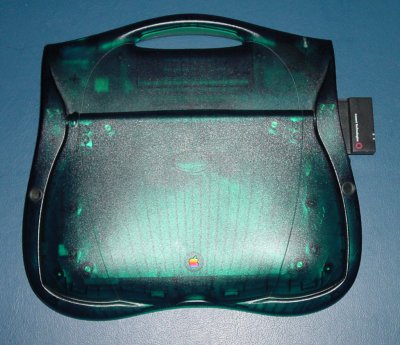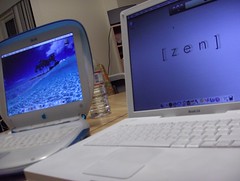Today, Newton Poetry celebrates its first anniversary. From its simple beginnings it’s grown and developed and changed into something not too far removed from the original idea.
A year ago, Newton Poetry started as a blog about poetry that I scribbled into my Newton MessagePad 110 and the translation that came out of the Newton’s handwriting recognition technology. Misspellings, garbled text, weird syntax – it was all par for the coarse, and tons of fun to read. I got my inspiration from Lewis Carroll’s famous “Jabberwocky” poem (hence my sub-headline) and the story behind it. But after a while, the act got old. I got bored, and I wanted to explore the history and mechanics of what made a ten-year-dead platform exciting and still relevant. What is a Newton? Why do people still devote free time to this machine? How can it be useful in this iPod Touch and iPhone age? Is Apple working on a new, revised Newton platform? How do you use a MessagePad in today’s OS X environment, a system never designed to handle the Newton’s serial-based connection?
There was something there, and there was a (admittedly small) audience. While the poetry stuff garnered plenty of views, it was mainly from search traffic; searchers were probably looking for meaningful analysis of the poem they were looking for, not some weird, misspelled translation. Whereas posts like getting an original Airport card working in a G3 iBook, or fixing up a PowerMac G4, drew tons of attention and discussion and comments, the poetry just…sat there. No love at all. Despite early experiments, no community formed around the idea of (a) submitting a poem, either famous or amateur and then (b) having some 15-year-old PDA spit out random text based on that poetry. And really, scribbling a poem and waiting for the response is tiring. It’s no fun anymore. Therefore, posts with poetry have dropped off. I just haven’t felt like doing them.
Posts on Newton history? Those I love.
Maybe it’s that I’m interested in poetry, and I’m interested in the Newton, but I’m not interested in the combination. At least not any more. There are no volunteers who are willing to do Newton poetry (that I know of), and I’ve given up on the idea of training apes to do the work.
Result: no more Newton poetry.
Merlin Mann’s post on blog pimping and writing about what you truly love hit a nerve with me. Those poetry posts generated plenty of hits. I didn’t write them because I wanted Google-trafficked attention, but I took a shot on building something out of a goofy idea. If I wanted a money-maker, or an attention whore, I could post a Newton poem a day and sit back as the hits kept coming.
But that’s not what I want to do. What I want to do is explore the Newton platform, and experiment with it, and run fun little projects on classic Macs, and eke out an blog existence that where I appreciate and enjoy spending time messing around. I look back at those Newton poems and…golly…I just don’t get misty eyed reading them, you know?
Newton Poetry might become a self-hosted blog. I have a goal to achieve before that happens, but it’s something I’ve spent more time and research on. Taking a WordPress.org trip into blogland is one of the last great experiments I can pull off with this thing. The idea makes me nervous, but I look at the blogs and sites I love reading, and all of them have benefited from the kind of modifications and customization that make a self-hosted blog worth doing. Graphics and a unique domain and tweakable CSS – I have no idea what I’m doing with any of that. But the question is: how else can I learn? How else can Newton Poetry grow?
There lies the rub, friends. What’s next? Where do we go from here?
Projects like the upcoming links page and the how-tos have helped develop Newton Poetry into a beast all its own. Newton fans and users have to have a home base in this day and age. Luckily, they have several. But as time goes on, more and more of those “page not found” messages will creep up. Newton-focused web sites are disappearing, and it’s up to a few of us die-hards to keep the tradition alive.
I don’t know how to program with NewtonScript, and I don’t know how to make a Bluetooth card work with a MessagePad 2100, and I sure don’t have the length of years behind me to remember when John Sculley first released the Newton MessagePad onto the thirsting masses. But boy I have fun with my Newton. And I know you do, too. Most of you give two shits about what happens with Apple, too, and many of you have iPhones to play with, and you wonder about the connection between today’s iCal and the MessagePad’s Calendar. You hit “send” on the the e-mail you just scrawled with a stylus or tapped out with the on-screen keyboard, and you understand how a non-physical input method can be a boon in today’s crazy world. You waste time playing Newtris on your Newton and the new Tetris on your iPhone, and you check out great sites like Blake and Arn’s TouchArcade and you remember when some of those simple games (chess, blackjack) first appeared on your monochrome Newton screen. And God Almighty, you curse the day Steve Jobs hit the big Reset button on the whole Newton ideal.
If any of that sounds like it might apply to you, then I hope you’ll find that Newton Poetry serves some purpose in your hectic life.
This whole thing was a shot in the dark a year ago. Everyday I watch that “today’s views” number creep up as some geek who just bought an eMate off eBay finds out how to connect his or her new toy to their iMac and a whole new world opens up right before his or her eyes. That’s what this site should be about. That’s my audience. That’s where I see this site going in the future. Because while I haven’t yet purchased a 2×00 MessagePad model and connected to the web via Wifi, I will, and I’ll explain how the heck I did it. Maybe that’ll help someone. Maybe it’ll just confuse others. Whatever. It’ll be damn fun to try.
It’s a new day, Dear Reader, with a more focused direction. File this in the “What Does It All Mean” folder, and read on. We have plenty more to talk about.











